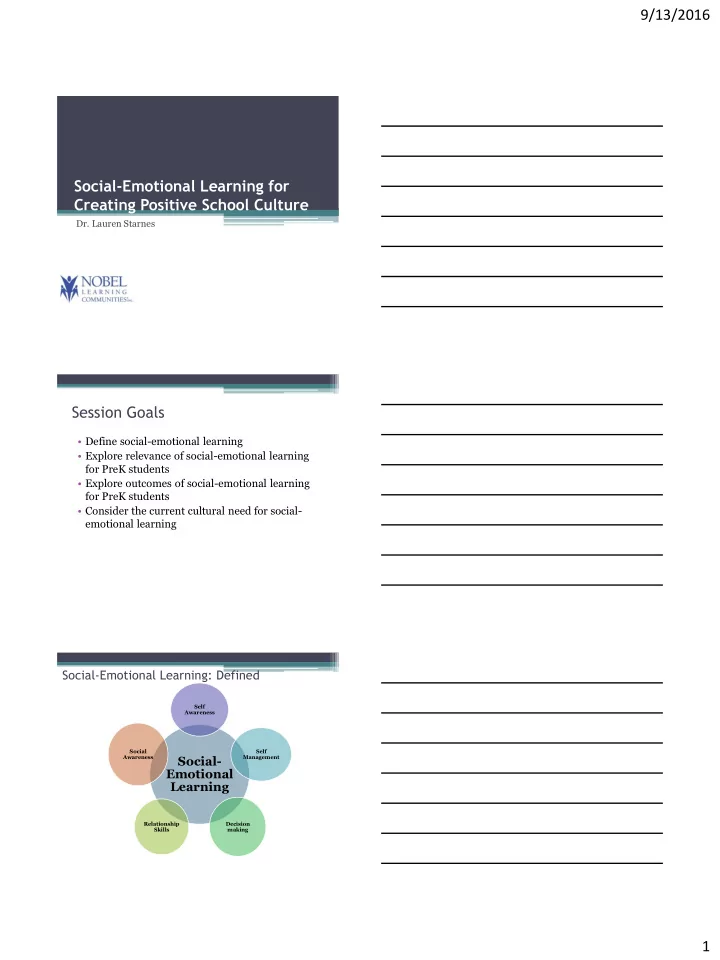

9/13/2016 Social-Emotional Learning for Creating Positive School Culture Dr. Lauren Starnes Session Goals • Define social-emotional learning • Explore relevance of social-emotional learning for PreK students • Explore outcomes of social-emotional learning for PreK students • Consider the current cultural need for social- emotional learning 3 Social-Emotional Learning: Defined Self Awareness Social Self Awareness Social- Management Emotional Learning Relationship Decision Skills making 1
9/13/2016 4 Importance of Social-Emotional Learning Mind Journey…. You tell me… Social-Emotional Learning in the Preschool Classroom Statistics Bullying begins early. Some studies show as many as 35% of elementary students are bullied or engage in bullying. Just shy of 20% of Kindergarten students report incidents of bullying Students who have been victims of Students who bully others are less likely bullying are more likely to be emotionally to see the behavior as wrong or be able to withdrawn and struggle academically in identify sadness and fear in others as they school. The stronger a student’s social and get older. emotional skills, the less likely the student is to bully others or be victims of bullying. Social-emotional learning is stronger when it begins earlier. 2
9/13/2016 POLL Promoting Social-Emotional Learning in the Early Childhood Classroom • Teach and model emotion vocabulary ▫ Naturally ▫ Prompted • Respectful teacher-student interactions ▫ Language ▫ Interactions • Modeling respectful language ▫ Using the word “respectful” ▫ Repeat and extend Promoting Social-Emotional Learning in the Early Childhood Classroom • Modeling and guiding peer interactions ▫ Replay social interactions ▫ Use emotion vocabulary • Practice social behaviors in play-based activities ▫ Guided play • Social-Emotional Learning programs • Inspect what we expect 3
9/13/2016 Social-Emotional Learning Effects SCHOOL CULTURE Families Teachers Class/ Peers Student Social-Emotional Learning Effects: Student • Academic achievement ▫ End of PreK testing score increase End of PreK Testing Data 100 95 Avg. Percentile 90 85 Pre SEL Year 1 Year 2 Year 3 SEL SEL SEL Social-Emotional Learning Effects: Student • Academic achievement ▫ Students who had SEL programs in PreK continued to outperform other students in end of Kindergarten testing ▫ Early effects, lasting effects 4
9/13/2016 Social-Emotional Learning Effects: Student • Improved classroom behavior ▫ Fewer behavior reports sent home • Longer attention spans ▫ Circle time less disrupted ▫ Classroom activities reflect higher engagement • Stronger diverse social interactions ▫ Less cliquey friendships Social-Emotional Learning Effects: Class • Fewer peer conflicts needing teacher intervention ▫ Peer problem solving • Greater collaboration ▫ Peer questioning before teacher questioning • Fewer emotional outbursts ▫ Less tears ▫ Less tantrums Social-Emotional Learning Effects: Teachers • Less time spent managing problem behavior • Less time spent navigating peer conflict • Higher feelings of parental support • Less turnover due to job dissatisfaction 5
9/13/2016 Social-Emotional Learning Effects: Families • Greater participation in school events • Stronger perception of school leadership • Stronger perception of school vision • Higher rates of parent support/volunteers • Higher rates of parent referrals Social-Emotional Learning Effect: Mental Tour Social-Emotional Learning Effects SCHOOL CULTURE Families Teachers Class/ Peers Student 6
9/13/2016 POLL Current Reality Contact Information Dr. Lauren Starnes Director of Early Childhood Education Nobel Learning Communities, Inc. Lauren . Starnes@nlcinc.com 7
Recommend
More recommend